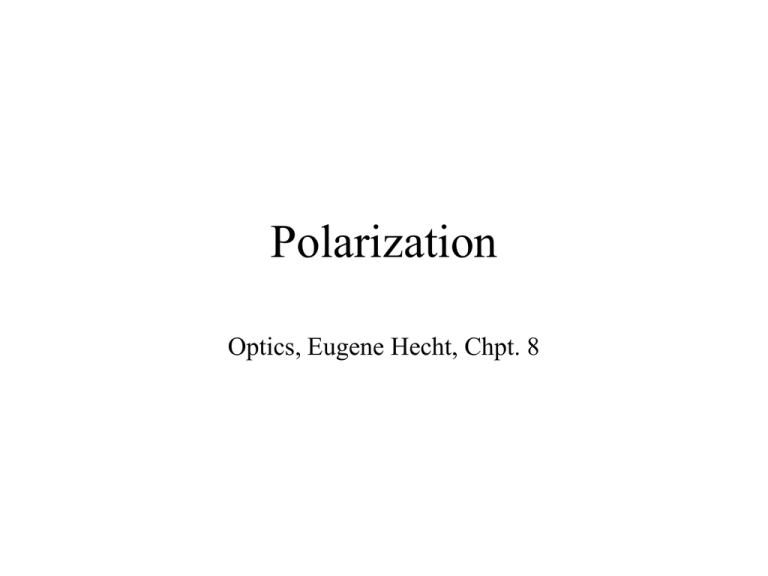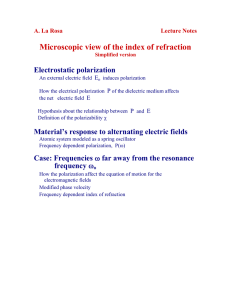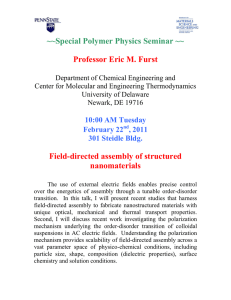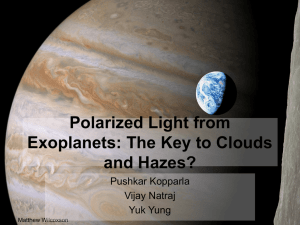Polarization
advertisement

Polarization Optics, Eugene Hecht, Chpt. 8 Linear polarization • E-field magnitude oscillates • Direction fixed • Arbitrary polarization angle – superposition of x and y polarized waves – real numbers Example 45 ° linear polarization Time evolution Circular polarization • E-field magnitude constant • Direction rotates • Complex superposition of x and y polarizations – x and y in quadrature Time evolution Example: right circular polarization Polarization summary • Decompose into x and y polarizations • Linear -- real superposition • Circular -- quadrature superposition Linear polarizations Ex Ex Ey Ey E+45 E-45 Circular polarizations Ex Ex i Ey i Ey ERight ELeft Angular momentum of light -- Spin • Circular polarized light has angular momentum • Like spin • Can induce electron spin flips – important for spectroscopy etc. Circular polarizations Ex Ex i Ey i Ey ERight ELeft Light angular momentum • Transverse laser modes • Addition rules Transverse laser modes (10) mode – similar to polarization - • Quadrature case + – wavefront is helix • “Orbital” angular momentum Linear addition Quadrature addition (10) (01) +45 (10) i (01) R. Helix (10) (01) - 45 (10) i (01) L. Helix Properties of helical beams • Interference fringes have discontinuity • Can have higher order • Number of extra fringes – order number (00) mode + R. Helix Elliptical polarization • General case – polarization partly linear and partly circular • E-field sweeps out ellipse – both magnitude and direction change with time • Superposition of L and R states Elliptical polarization Superposition of L and R Producing linear polarization -- 1 • Induce loss for one polarization direction • Examples: wire grid, polaroid filter Producing linear polarization -- 2 • Separation in birefringent crystal -- ex: calcite • Ordinary wave -- behaves as expected • Extra-ordinary wave -- behaves differently – example -- E-field not perpendicular to propagation direction • Input light converted to two polarized beams Producing linear polarization -- 3 • • • • • Brewster’s angle Only one polarization reflected Reflected light polarized Works with most surfaces Good way to calibrate polarizers Refracted beam creates dipoles in medium Brewster angle: dipole field zero perpendicular to reflection prop. direction Polarizing cubes • Uses fact that total internal reflection close to Brewster’s angle – reflection large for other polarization • Multi-layer coating enhances effect – reflections from multiple surfaces -- resonance • Brewster polarization reflection always zero Waveplates • Polarization converters • One linear polarization direction propagates faster • Half wave plate -- phase delay 180° Rotate linear pol. by angle 2q – rotate linear polarization up to 90° – fast axis at 45° to input polarization direction • Quarter wave plate -- phase delay 90° – convert linear to circular polarization – R or L for fast axis +45 or -45 to input pol. Create circular polarization Retardation of one polarization Other circular polarizers • Use phase shift for total internal reflection – 45° over broad range of angles • Two reflections give 90° • Converts linear to circular polarization Optical activity • • • • Rotate linear polarization Express linear as sum of R and L Different propagation speeds Phase delays give rotation Input linear polarization as sum of R and L Rotated linear polarization as sum of R and L Uses of optical activity • Organic molecule ID – right and left handed molecules – Example: helical molecule • Biological molecule ID – almost always pure right or left – not mixture Faraday effect • • • • • Magnetic field induces polarization rotation Orients electron spins in medium Angular momenta of electrons and photons interact R and L have different propagation delays Useful for magnetometers – example: rubidium vapor Light polarization\ direction Electron orbit B-field Pockels effect Electro optic effect – linear in applied field • Polarization in direction of applied field changes propagation speed • Requires crystal with no center of symmetry -- also piezoelectric • Delay linear in applied field -- Kerr effect quadratic Kerr effect Retardation nonlinear in applied voltage All materials can have Kerr effect, but need higher voltage • In direction of applied field -- phase modulator • Perpendicular to applied field -- nothing • 45° to applied field -- variable waveplate – output polarizer gives intensity modulator Liquid crystals • Electric field changes average orientation of molecules – Delay depends on polarization direction – Kerr effect most common • Phase modulator or variable waveplate • Intensity modulator needs polarizers • Used for displays -- ex: computer monitors Isolators -- 1 • Polarizer and quarter waveplate • Double pass through quarter wave plate – same as half wave plate – rotate polarization by up to 45° • Polarizer blocks reflected light Polarizer Quarter wave Reflecting element Isolators -- 2 • Faraday effect non-reciprocal – Opposite for different propagation directions • Put passive polarization rotator and Faraday rotator in series – One direction -- no effect – Opposite direction -- rotate polarization 90° • Polarizer blocks reflections • Used for fiber optics, laser diodes – performance good -- 10 - 30 dB Polarizer Faraday crystal magnet Rotation depends on propagation direction Adds on reflection Passive rotator (optional in reflecting configuration) Ex: optically active crystal Reflecting element Circular polarization reverses sense on reflection Mathematical description of polarization • Stokes vectors • Elements give: – – – – 1/2 total intensity I0 / 2 horizontal linear 2 I 0 / 2 I H +45° linear I 0 I 0 / 2 I 45 right circular I0 / 2 I R • Jones vectors • Elements give – E-field x-component E x – E-field y-component E y • Only applicable to polarized light Unpolarized state only I0 is non-zero Stokes and Jones vectors • Special cases of pure polarization Action of optical elements • matrix Example -- vertical polarizer • input H state -- zero output • input V state -- no effect 1 1 1 1 1 2 0 0 0 0 0 0 0 0 0 0 0 0 Jones and Mueller matrices • Stokes parameters used in: – Target ID -- spectral-polarmetric – Quantum computing • V,H and +45,-45 entangled • can only measure in one basis • measurement destroys info in other basis




